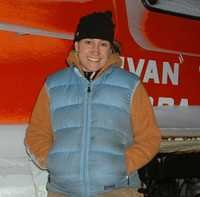Happy Thanksgiving! For those of you sitting warm inside, watching football and smelling the turkey roasting I want you to send a warm thought to our friends on the ice who are not eating turkey. To give a glimpse of what Thanksgiving can be like on the ice, I'm offering up the first few paragraphs of Traci McNamara's richly detailed essay from Antarctica: Life on the Ice. The woman in blue with the marvelous warm smile is Traci. Enjoy!
We Ate No Turkey: A Holiday on Ice
Instead of spending Thanksgiving Day as I usually did in Colorado Springs—watching the Macy’s parade on TV in my pajamas--I was shivering in my work clothes on the McMurdo Ice Shelf, learning how to make a storm-worthy shelter by cutting dense snow into blocks with a paper-thin saw. Snowcraft, as our mountain-savvy instructor called it, was only one portion of McMurdo Station, Antarctica’s two-day survival skills course optimistically called Happy Camper School.
The course, required of all workers and scientists at McMurdo, started
on a Thursday morning in the Field Safety Training Program conference
room, where our instructor Brian led twelve first-timers to Antarctica
through the lecture portion of the course. Novices, we were. But it
was Brian’s job to get us into Extreme Cold Combat Shape in less than
forty-eight hours, and by the end of our tenure on the ice shelf, we
would be firing up stoves and lashing down mountain tents, all—of
course—with great rapidity in order to outsmart the gale-force winds
and popsicle-death scenarios he concocted in order to keep us moving
quickly. When he wasn’t in Antarctica, Brian—tight-bodied and exuding
a spirit of adventure--worked as a guide in Alaska, but at McMurdo, he
was a member of the highly respected Field Safety Training Program team
(F-STOP for short), a group of sexy men and women who spent their lives
in rugged environments and then migrated south for the austral summer
to teach McMurdo’s scientists and support staff how to survive them.
After Brian introduced us to our Happy Camper objectives, he briefed us
on cold-weather health hazards, their symptoms, and their remedies.
Before lunch, I felt confident knowing the basics of hypothermia and
its telltale signs—the fumbles, mumbles, and grumbles.
“Talk to your partners to determine their LOC,” Brian said while
pointing to a white board scribbled with notes about how cold weather
affects a person’s level of consciousness, “and help them out before
they get into that irreversible phase. If you notice that anything’s
off, start with some food and water and get them moving around.”
Besides those suggestions, Brian offered a few other ideas about how to
prevent and treat hypothermia while he gestured with his hands and we
watched, motionless and mostly bored, from our chairs.
Of hypothermia’s remedies, one above the others captured my
imagination. F-STOP Brian told us that it is possible to warm up a
hypothermic body by stripping it naked and putting it in close
proximity to another naked body. “In extreme cases,” he clarified, “you
can use direct body heat to re-warm a hypothermic individual.”
Ideally, the second naked body would be warm, and these two naked
bodies together would be skin-to-skin within a sleeping bag so that an
ailing individual could reap the thermodynamic benefits. A few giggles
followed and a few glanced around the room.
To read the rest of the essay you have to buy the book! www.susanfoxrogers.com
